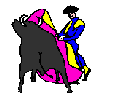 |
Spain | Travel | Regions | Cities | Coasts | Islands | Culture |
| Spain / Country and Culture / Bullfight / History |
|
| More Information | ||
| Destinations | ||
| Plan your Trip | ||
| ||||||
 Bullfighting is certainly one of the best known, although at the same time most polemical Spanish popular customs.
Bullfighting is certainly one of the best known, although at the same time most polemical Spanish popular customs.This Fiesta could not exist without the Toro Bravo, a species of bull of an archaical race that is only conserved in Spain. Formerly this bull's forebears, the primitive urus, were spread out over wide parts of the world. Many civilizations revered to them, the bull-cultus at the Greek island Creta is quite well-known. The Bible reports on sacrifices of bulls in honour to the divine justice. Also in the religious ceremonies of Iberian tribes living in Spain in prehistorical times bulls played an important part. The origins of the Plaza, bullring, probably are not the Roman amphitheaters but the Celt-Iberian temples where those ceremonies were held. In the province of Soria, close to Numancia, one of them is conserved and it is supposed that there bulls were sacrificed to the Gods. While the religious cultus to the bull goes back to Iberians, it were the Greek and Roman influences that converted it into a spectacle. During the middle-ages it was a diversion for the aristocracy to torear on horse's back. That was called suerte de cañas. In 18th century this tradition was more or less abandoned and the poorer population invented the bullfight by foot. Francisco Romero was a key-figure in laying the rules for that new sport. For its fans La Corrida is of course rather an art than a sport, not to speak about the challenge of the man fighting against the beast. It is an archaic tradition that has survived in this country, just as the Toro Bravo has done. More about Bullfight: What a Corrida is about? | Books about Bullfighting |